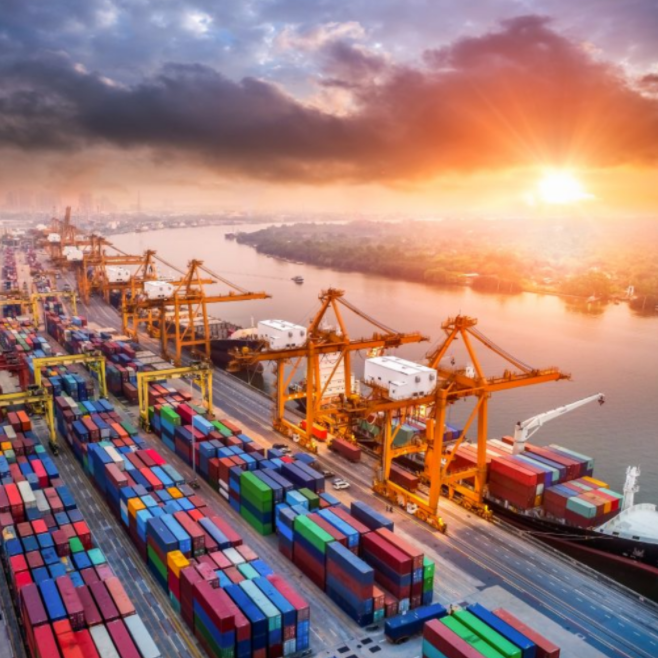Growth of the global economy, driven not least by the US and China, is gathering pace. Although Europe is lagging behind, it is likely that the region will be dragged along by the strength of the consumer and manufacturing boom already being experienced by the world’s largest economies. But what does this mean for the global logistics industry in the short and medium term? John Manners-Bell, Founder of the Foundation for Future Supply Chain, highlights five key ways in which the global logistics industry will be affected.
- More M&A – led by shipping lines
Administrations, led by the US, have invested huge amounts in stimulus packages and this, combined with re-stocking activity, has driven the present surge in international shipments of goods. The primary beneficiaries of this trend have been container shipping lines which are operating at full capacity and able to charge historically high rates. This has created enormous cash resources for this sector of the logistics industry (one investor estimates combined profits of $9 billion in Q4 2020 alone), facilitating many shipping lines’ existing plans to transform their business models. One result of this pot of cash will be further consolidation in the sector but, more importantly for the wider industry, it could also prompt acquisitions to expand end-to-end services (as seen with CMA CGM’s purchase of CEVA) and purchases which increase capabilities (such as Maersk’s acquisition of KGH Customs Services).
- Pressure on labour
The stimulus packages are aimed at creating demand for goods and services and this will necessarily generate jobs. However, in many parts of the transportation and logistics industry there are already shortages of labour and a boost for the wider economy will simultaneously increase the demand for workers whilst reducing the pool of available staff.
There are two possible results. Wage inflation is the greatest risk and this will increase consumer prices (with possible consequences for interest rates). However, companies will also be incentivised to invest in warehouse automation which will improve productivity.
Transport will also be affected. During lockdowns many drivers which worked in personal mobility sectors for companies such as Uber have transferred to the on-demand delivery sector. Now that lockdowns around the world are ending there will be additional competition for their services, increasing the level of their remuneration.
- Opportunities for digital platforms
Related to the above, digital platforms which offer efficiency improvements for the transportation industry will gain traction. It is generally accepted that truck capacity is under-utilised and so marketplaces which better match supply and demand will play an important role in keeping a lid on inflationary pressures. Other productivity-increasing supply chain execution technologies, such as routing software, Transport Management Systems (TMS) and control towers, to name a few, will be boosted not only by the need to improve efficiency but also by the underlying increase in volumes passing through networks.
- Investment in sustainability
The surge in shipment volumes and consequent rise in transport output will have an immediate effect on transport-generated carbon emissions putting many companies’ sustainability targets at risk. However, in the longer term a more profitable sector will facilitate greater investment in cleaner technologies. This will include the transition to clean energy vehicles in the road freight/trucking sector; development of biofuel and/or electric powered aircraft as well as alternative fuels for the shipping sector. Given soaring carbon emissions, companies will come under increasing pressure from shareholders, governments and consumers to re-double their efforts to reduce their environmental impact.
- Investment in warehouse property
After a year of constrained opportunities for consumers (and businesses) to spend money, the lifting of lockdown regulations, stimulus packages and the increase in personal savings will mean a sustained lift in retail sales. Volumes will increase for many parts of the retail sector, especially those selling bigger ticket items such as white goods, and subsequently there will be pressure on warehousing capacity.
The Covid crisis has already resulted in a boom for e-commerce sales and this has become engrained behaviour for many parts of society. In order to meet these needs, significantly more warehousing space will be required, catering for intensive picking of single-items; smaller, more frequent deliveries as well as higher levels of automation and robotics. The location of distribution centres will also change, taking into account the trend towards same day or even on-demand deliveries of orders.
Summarising the situation faced by the logistics industry, Manners-Bell commented, ‘For the most part, the transport and warehousing sector has weathered the Covid crisis very well and was already in a strong position to take advantage of the economic rebound. Stimulus packages, high levels of savings and re-stocking will mean that 2021 will be a bumper year for the industry – despite capacity constraints being experienced by ports and shipping. The profits generated will create the conditions for market transformation through significant M&A activity as well as investment in new warehousing and transport technologies which will make the industry more sustainable.’
Source: Foundation for Future Supply Chain
Author: John Manners-Bell





